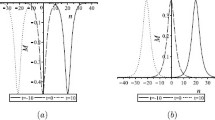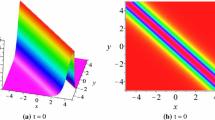Abstract
A 2+1 dimensional Volterra type system with nonzero boundary conditions is considered. The Dbar dressing method based on a single-valued variable is discussed. The explicit solutions, including line-solitons and rational solutions of the Volterra type system are considered on certain new variables.










Similar content being viewed by others
Data availability
Data will be made availability on reasonable request.
References
Mikhailov, A.V.: Integrability of a two-dimensional gemeralization of the Toda chain. Sov. Phys.-JETP Lett. 30, 443–448 (1979)
Villarroel, J., Chakravarty, S., Ablowitz, M.J.: On a 2+1 Volterra system. Nonlinearity 9, 1113–1128 (1996). https://doi.org/10.1088/0951-7715/9/5/004
Zhang, Y.N., He, Y., Tam, H.W.: One variant of a (2+1)-dimensional Volterra system and its (1+1)-dimensional reduction. Front. Math. China 8, 1085–1097 (2013). https://doi.org/10.1007/s11464-013-0308-8
Sahadevan, R., Khousalya, S.: Similarity reduction of a (2+1) Volterra system. J. Phys. A Math. Gen. 33, L171–L176 (2000). https://doi.org/10.1088/0305-4470/33/19/102
Huang, Q., Gao, Y., Jia, S., Wang, Y., Deng, G.: Bilinear Bäcklund transformation, soliton and periodic wave solutions for a (3+1)-dimensional variable-coefficient generalized shallow water wave equation. Nonlinear Dyn. 87, 2529–2540 (2017). https://doi.org/10.1007/s11071-016-3209-z
Cao, Y., He, J., Mihalache, D.: Families of exact solutions of a new extended (2+1)-dimensional Boussinesq equation. Nonlinear Dyn. 91, 2593–2605 (2018). https://doi.org/10.1007/s11071-017-4033-9
Foroutan, M., Manafian, J., Ranjbaran, A.: Lump solution and its interaction to (3+1)-D potential-YTSF equation. Nonlinear Dyn. 92, 2077–2092 (2018). https://doi.org/10.1007/s11071-018-4182-5
Zhang, Y., Rao, J., Porsezian, K., He, J.: Rational and semi-rational solutions of the Kadomtsev-Petviashvili-based system. Nonlinear Dyn. 95, 1133–1146 (2019). https://doi.org/10.1007/s11071-018-4620-4
Li, B., Ma, Y.: Interaction dynamics of hybrid solitons and breathers for extended generalization of Vakhnenko equation. Nonlinear Dyn. 102, 1787–1799 (2020). https://doi.org/10.1007/s11071-020-06024-4
Zhang, R., Li, C., Yin, H.: Rogue wave solutions and the bright and dark solitons of the (3+1)-dimensional Jimbo-Miwa equation. Nonlinear Dyn. 103, 1071–1079 (2021). https://doi.org/10.1007/s11071-020-06112-5
Mukam, S., Souleymanou, A., Kuetche, V., Bouetou, T.: Generalized Darboux transformation and parameter-dependent rogue wave solutions to a nonlinear Schrödinger system. Nonlinear Dyn. 93, 373–383 (2018). https://doi.org/10.1007/s11071-018-4198-x
Xu, S., He, J., Mihalache, D.: Rogue waves generation through multiphase solutions degeneration for the derivative nonlinear Schrödinger equation. Nonlinear Dyn. 97, 2443–2452 (2019). https://doi.org/10.1007/s11071-019-05140-0
Ji, T., Zhai, Y.: Soliton, breather and rogue wave solutions of the coupled Gerdjikov-Ivanov equation via Darboux transformation. Nonlinear Dyn. 101, 619–631 (2020). https://doi.org/10.1007/s11071-020-05790-5
McAnally, M., Ma, W.: Explicit solutions and Darboux transformations of a generalized D-Kaup-Newell hierarchy. Nonlinear Dyn. 102, 2767–2782 (2020). https://doi.org/10.1007/s11071-020-06030-6
Geng, X., Li, Y., Xue, B.: A second-order three-wave interaction system and its rogue wave solutions. Nonlinear Dyn. 105, 2575–2593 (2021). https://doi.org/10.1007/s11071-021-06727-2
Ablowitz, M.J., Yaacov, D.B., Fokas, A.S.: On the inverse spectral transform for the Kadomtsev-Petviashvili equation. Stud. Appl. Math. 69, 135–143 (1983). https://doi.org/10.1002/sapm1983692135
Beals, R., Coifman, R.R.: The D-bar approach to inverse scattering and nonlinear evolutions. Phys. D 18, 242–249 (1986). https://doi.org/10.1016/0167-2789(86)90184-3
Gilbert, R.P.: Remarks on matrix hierarchies, d bar dressing, and the spectral transform. Appl. Anal. 51, 1–33 (1993). https://doi.org/10.1080/00036819308840201
Zakharov, V., Manakov, S.V.: Construction of higher-dimensional nonlinear integrable systems and of their solutions. Func. Anal. Appl. 19, 89–101 (1985). https://doi.org/10.1007/BF01078388
Konopelchenko, B.G.: Introduction to multidimensional integrable equations: the inverse spectral transform in 2+1-dimensions. Plenum press, New York and London (1992)
Manakov, S.V.: The inverse scattering transform for the time-dependent Schrödinger equation and Kadomtsev-Petviashvili equation. Phys. D 3, 420–427 (1981). https://doi.org/10.1016/0167-2789(81)90145-7
Beals, R., Coifman, R.R.: Linear spectral problems, non-linear equations and the \({\bar{\partial }}\)-method. Inverse Problems 5, 87–130 (1989). https://doi.org/10.1088/0266-5611/5/2/002
Bogdanov, L.V., Manakov, S.V.: The non-local \({\bar{\partial }}\) problem and (2+1)-dimensional soliton equations. J. Phys. A: Math. Gen. 21, L537–L544 (1988). https://doi.org/10.1088/0305-4470/21/10/001
Dubrovsky, V.G.: The construction of exact multiple pole solutions of some (2+1)-dimensional integrable nonlinear evolution equations via the \({\bar{\partial }}\)-dressing method. J. Phys. A Math. Gen. 32, 369–390 (1999). https://doi.org/10.1088/0305-4470/32/2/011
Dubrovsky, V.G., Topovsky, A.V.: Multi-lump solutions of KP equation with integrable boundary via \({\bar{\partial }}\)-dressing method. Phys. D 414, 132740 (2020). https://doi.org/10.1016/j.physd.2020.132740
Dubrovsky, V.G., Topovsky, A.V.: Multi-soliton solutions of KP equation with integrable boundary via \({\bar{\partial }}\)-dressing method. Phys. D 428, 133025 (2021). https://doi.org/10.1016/j.physd.2021.133025
Dubrovsky, V.G., Topovsky, A.V., Basalaev, M.Y.: New exact solutions of two-dimensional integrable equations using the \({\bar{\partial }}\)-dressing method. Theoret. Math. Phys. 167, 725–739 (2011). https://doi.org/10.1007/s11232-011-0057-3
Konopelchenko, B.G., Dubrovsky, V.G.: Inverse spectral transform for the modified Kadomtsev-Petviashvili equation. Stud. Appl. Math. 86, 219–268 (1992). https://doi.org/10.1002/sapm1992863219
Konopelchenko, B.G., Matkarimov, B.T.: Inverse spectral transform for the nonlinear evolution equation generating the Davey-Stawartson and Ishimori equation. Stud. Appl. Math. 82, 319–359 (1990). https://doi.org/10.1002/sapm1990824319
Kuang, Y.H., Zhu, J.Y.: A three-wave interaction model with self-consistent sources: the \({\bar{\partial }}\)-dressing method and solutions. J. Math. Anal. Appl. 426, 783–793 (2015). https://doi.org/10.1016/j.jmaa.2015.01.072
Luo, J.H., Fan, E.G.: Dbar-dressing method for the Gerdjikov-Ivanov equation with nonzero boundary conditions. Appl. Math. Lett. 120, 107297 (2021). https://doi.org/10.1016/j.aml.2021.107297
Wang, X.R., Zhu, J.Y.: Dbar-approach to coupled nonlocal NLS equation and general nonlocal reduction. Stud. Appl. Math. 148, 433–456 (2022). https://doi.org/10.1111/sapm.12445
Wang, X.R., Zhu, J.Y., Qiao, Z.J.: New solutions to the differential-difference KP equation. Appl. Math. Lett. 113, 106836 (2021). https://doi.org/10.1016/j.aml.2020.106836
Wang, Z.Y., Tian, S.F., Cheng, J.: The \({\bar{\partial }}\)-dressing method and soliton solutions for the three-component coupled Hirota equations. J. Math. Phys. 62, 093510 (2021). https://doi.org/10.1063/5.0046806
Yurova, M.: Application of dressing method for long wave-short wave resonance interaction equation. J. Math. Phys. 48, 053516 (2007). https://doi.org/10.1063/1.2719562
Zhu, J.Y., Geng, X.G.: A hierarchy of coupled evolution equations with self-consistent sources and the dressing method. J. Phys. A Math. Theor. 46, 035204 (2013). https://doi.org/10.1088/1751-8113/46/3/035204
Zhu, J.Y., Geng, X.G.: The AB equations and the \({\bar{\partial }}\)-dressing method in semi-characteristic coordinates. Math. Phys. Anal. Geo. 17, 49–65 (2014). https://doi.org/10.1007/s11040-014-9140-y
Zhu, J.Y.: Line-soliton and rational solutions to (2+1)-dimensional Boussinesq equation by Dbar-problem. arXiv: 1704.02779
Zhu, J.Y., Jiang, X.L., Wang, X.R.: Dbar dressing method to nonlinear Schrödinger equation with nonzero boundary conditions. arXiv: 2011.09028
Dai, H.H., Geng, X.G.: Decomposition of a 2+1-dimensional Volterra type lattice and its quasi-periodic solutions. Chaos Soliton. Fract. 18, 1031–1044 (2003). https://doi.org/10.1016/s0960-0779(03)00061-4
Funding
The author declares that no funds were received during the preparation of this manuscript.
Author information
Authors and Affiliations
Corresponding author
Ethics declarations
Conflict of interest
The author declares that he has no conflict of interest.
Additional information
Publisher's Note
Springer Nature remains neutral with regard to jurisdictional claims in published maps and institutional affiliations.
Appendix
Appendix
Here, we deduce the 2+1 dimensional Volterra type system (2). Acting E and \(E^{-1}\) to (14) follow that
Substituting (14) and (A.1) into (12), we have
and it is clear to find that
which is the second equation of (2).
Acting E to (15) follows that
substituting (15) and (A.3) into (16), we have
noting that
Substituting (A.1), (A.5) into (A.4) and acting \(1-E\) to (A.4) afterwards, we have
according to (14) and (A.1), we have
Substituting (A.7) and (11) into (A.6), we get
then (A.8) multiplies \(a_n\) and substituting (12) into the result, we can obtain
which is the first equation of (2).
Rights and permissions
Springer Nature or its licensor holds exclusive rights to this article under a publishing agreement with the author(s) or other rightsholder(s); author self-archiving of the accepted manuscript version of this article is solely governed by the terms of such publishing agreement and applicable law.
About this article
Cite this article
Liu, T. A 2+1 dimensional Volterra type system with nonzero boundary conditions via Dbar dressing method. Nonlinear Dyn 111, 671–682 (2023). https://doi.org/10.1007/s11071-022-07855-z
Received:
Accepted:
Published:
Issue Date:
DOI: https://doi.org/10.1007/s11071-022-07855-z
Keywords
- 2+1 dimensional Volterra type system
- Dbar dressing method
- Nonzero boundary conditions
- Explicit solutions




